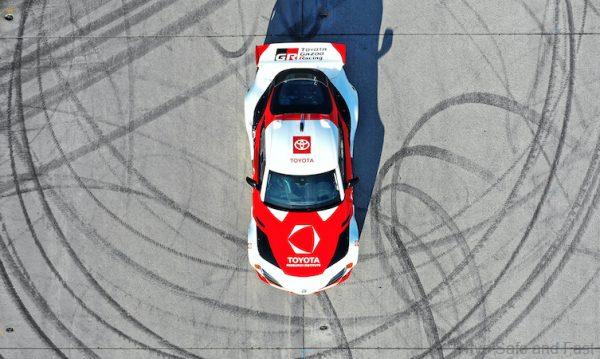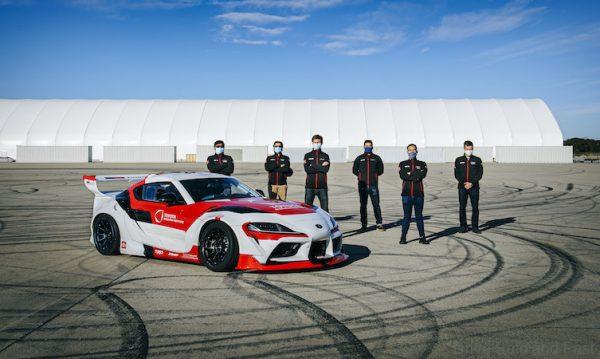Toyota Just Taught A Supra How To Autonomously Drift
When it comes to self-driving technology, news has become sort of stale. Elon Musk made some headlines when he decided that Tesla should roll out ‘Autopilot’ without using LiDAR (and without it being very autonomous). Since then, loads of companies have come out saying they’ve got the most cutting edge driverless technology really capturing the public’s imagination.

Well, rather than try and make a publicity stunt out of self-driving tech, Toyota have decided to make one out of self-drifting! A collaboration between the Toyota Research Institute and Standard’s Dynamic Design Lab have created a GR Supra that can drift without a driver! Why? Well it’s obviously pretty cool, but there’s a deeper reason to it: Toyota wanted to see if they could give a self-driving car the ‘reflexes’ of a professional race car driver.
Turns out they can. And that could be a really important thing for road safety. Sometimes crashes are unavoidable not just because of human error, but also because of human limitations. Most drivers just aren’t fast enough to react to very unexpected and dangerous situations even when they’re paying attention and have got everything else in order.

It is hoped that giving cars active safety that mirrors the skills possessed by professional race car drivers, extreme road accident scenarios can be made less fatal. In countries where roads can freeze over and become slippery, a traditional self-driving car may not be able to compensate for the loss of traction through braking. If the situation allows for it, a controlled drift through the ice may be the safest way through.

Pretty cool, we must say.

More in the press release below.
PRESS RELEASE
Meet the world’s first (and only) self-drifting GR Supra, which has been created by a joint collaboration of researchers at Toyota Research Institute and Stanford’s Dynamic Design Lab, with the aim of reducing road traffic accidents.
Based around the question, ‘What if every driver who ran into trouble had the instinctive reflexes of a professional race car driver and the calculated foresight of a supercomputer to avoid a crash?’ the self-drifting GR Supra is seeking to combine the technology of vehicle automation with artificial intelligence algorithms.
Inspired by professional drift drivers, the engineers are conducting research on how to bring together the instincts of racing drivers and automated driving technology, with the self-drifting GR Supra as their testbed. The end goal is to design a new level of active safety technology and share it broadly so that Toyota and other auto manufacturers can deploy it on the road.
“Every day, there are deadly vehicle crashes that result from extreme situations where most drivers would need superhuman skills to avoid a collision,” said Gill Pratt, TRI CEO and Chief Scientist at Toyota Motor Corporation (TMC). “The reality is that every driver has vulnerabilities, and to avoid a crash, drivers often need to make manoeuvres that are beyond their abilities. Through this project, TRI will learn from some of the most skilled drivers in the world to develop sophisticated control algorithms that amplify human driving abilities and keep people safe. This is the essence of the Toyota Guardian™ approach.”
Every year, car crashes result in nearly 40,000 fatalities in the United States and about 1.25 million fatalities worldwide. Toyota’s goal is to reduce that number to zero. While most crashes occur in mundane situations, in other situations drivers may need to make manoeuvres that take their vehicle close to and, at times, exceed normal limits of handling. When faced with wet or slippery roads, for instance, professional drivers may choose to ‘drift’ the car through a turn.
“Since 2008, our lab has taken inspiration from human race car drivers in designing algorithms that enable automated vehicles to handle the most challenging emergencies,” said Professor Chris Gerdes of Stanford University’s Dynamic Design Laboratory. “Through this research, we have the opportunity to move these ideas much closer to saving lives on the road.”
TRI has supported the Dynamic Design Lab’s research for many years. The current project draws upon Stanford’s published paper, “Opening New Dimensions: Vehicle Motion Planning and Control using Brakes while Drifting,” in which Stanford researchers demonstrated advanced drifting on MARTY, an electrified, automated DeLorean. Stanford’s experimental results produced a proof-of-concept architecture capable of controlling a rear-wheel-drive vehicle in a drift using brakes, steering and propulsion. TRI is now applying this architecture to vehicle platforms, including the GR Supra.
TRI is also engaging Toyota’s engineering expertise in motorsports and advanced development. Toyota Racing Development in the United States is providing valuable technical and experiential know-how in motorsports and drifting. Separately, TRI is also working with Toyota Motor Corporation’s Vehicle Dynamics Control Team — based in Japan — to apply the drifting architecture for future Toyota vehicles.